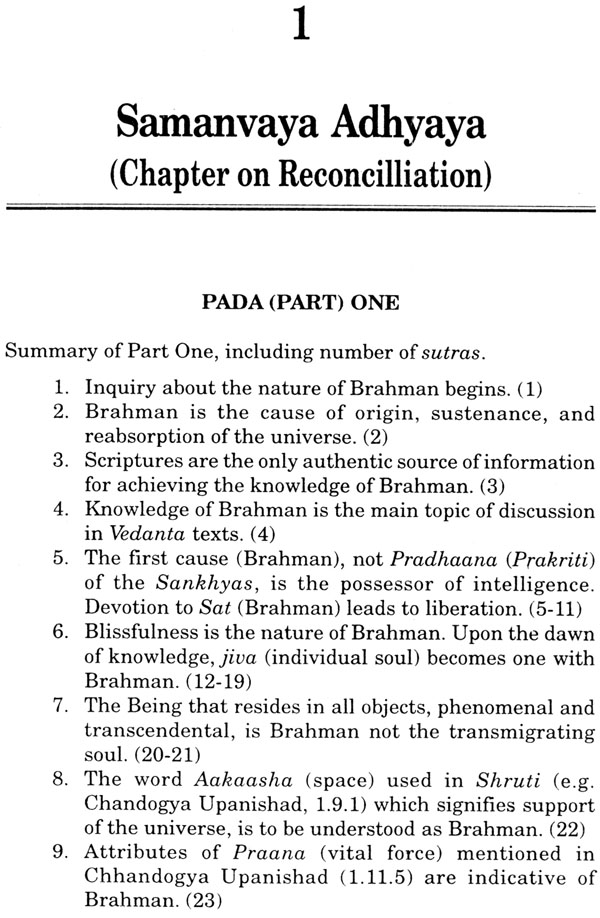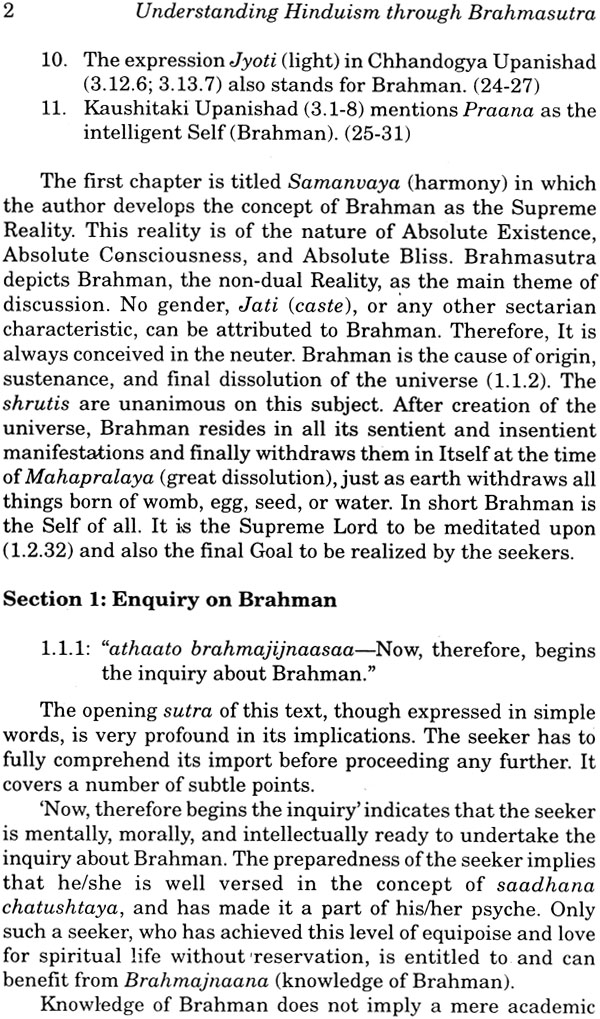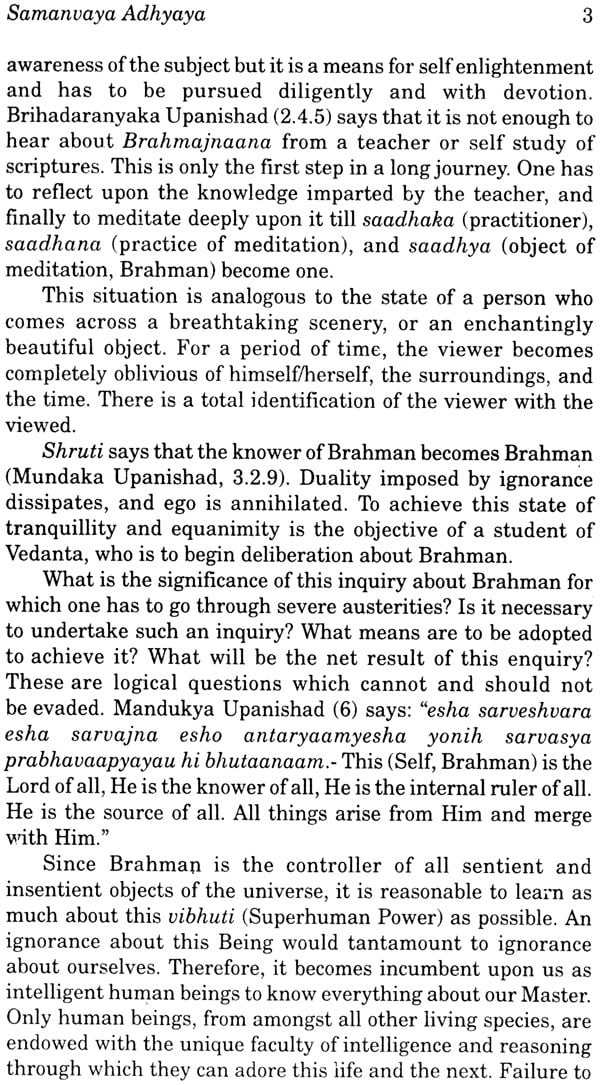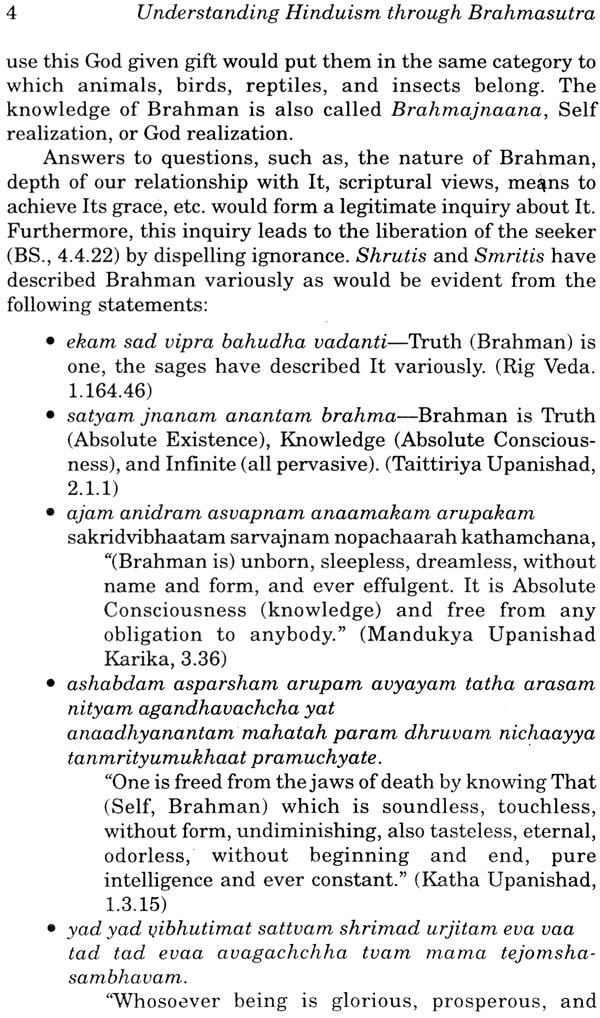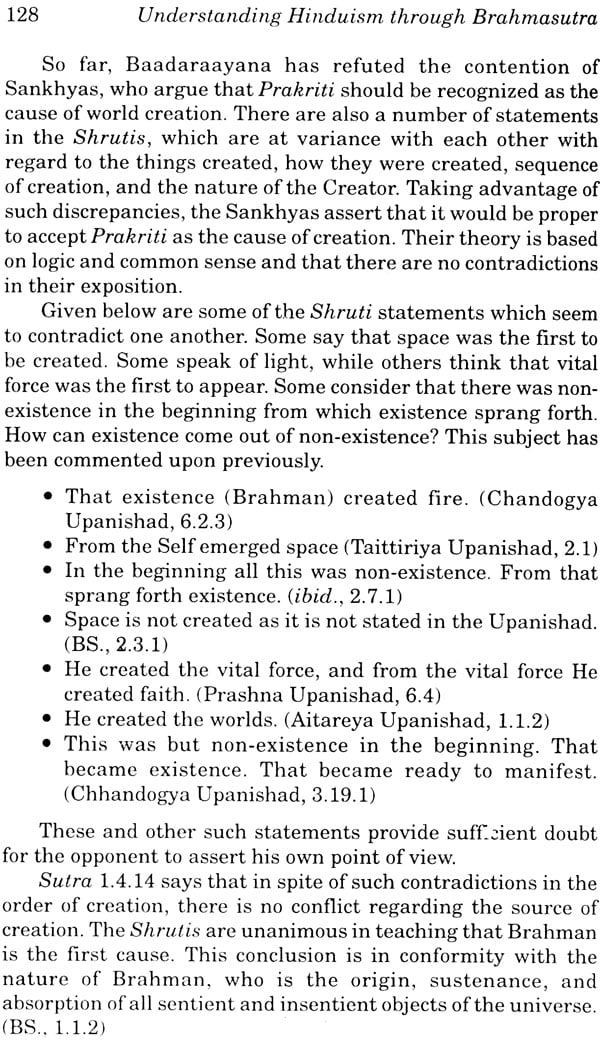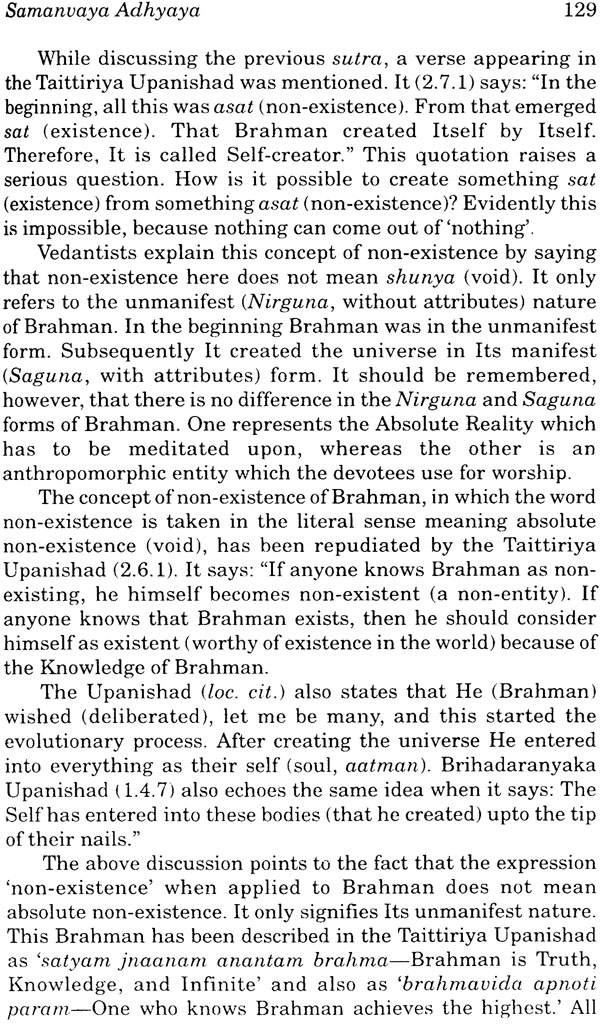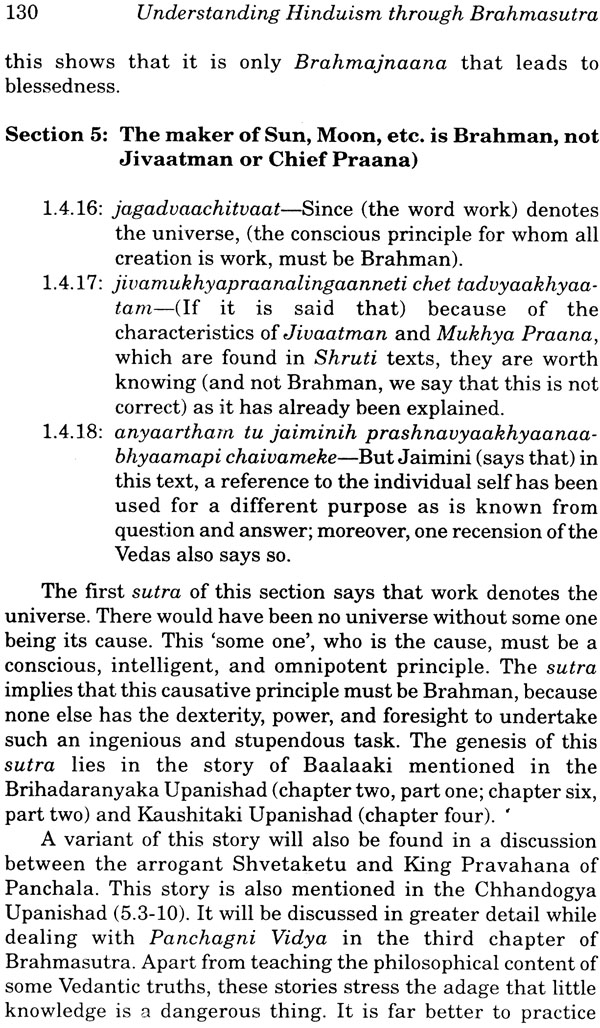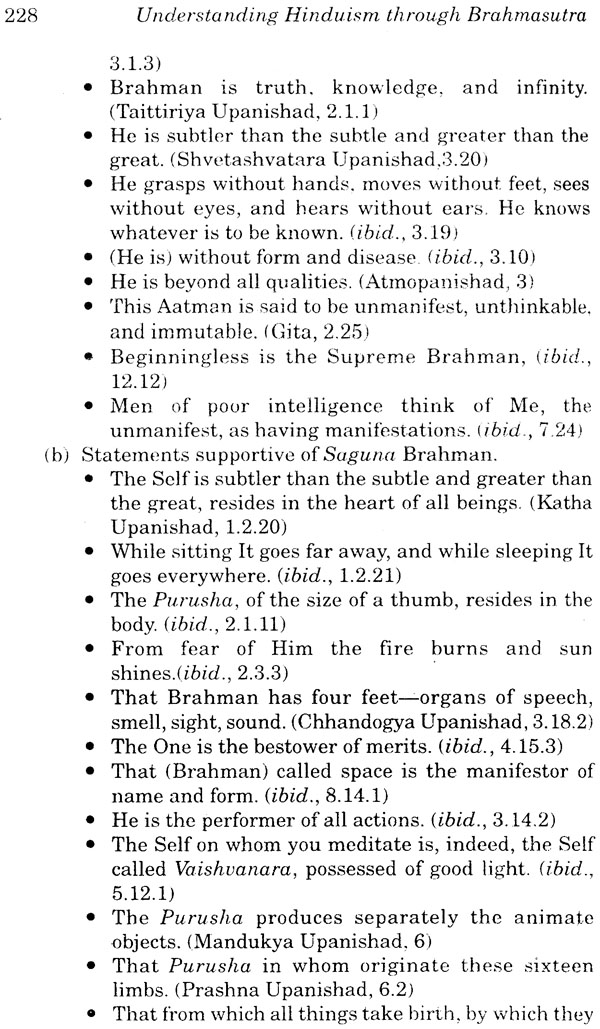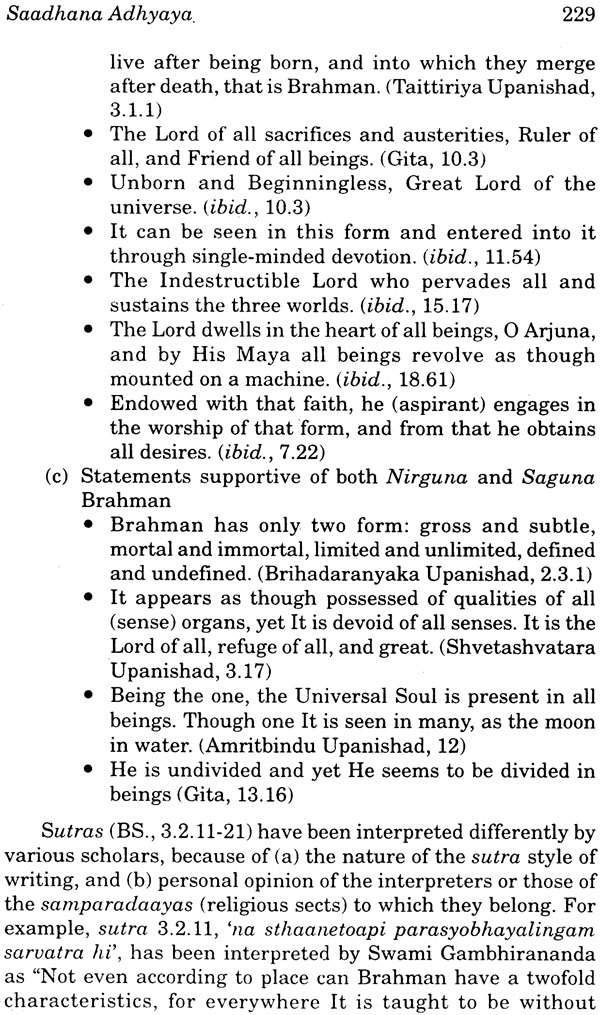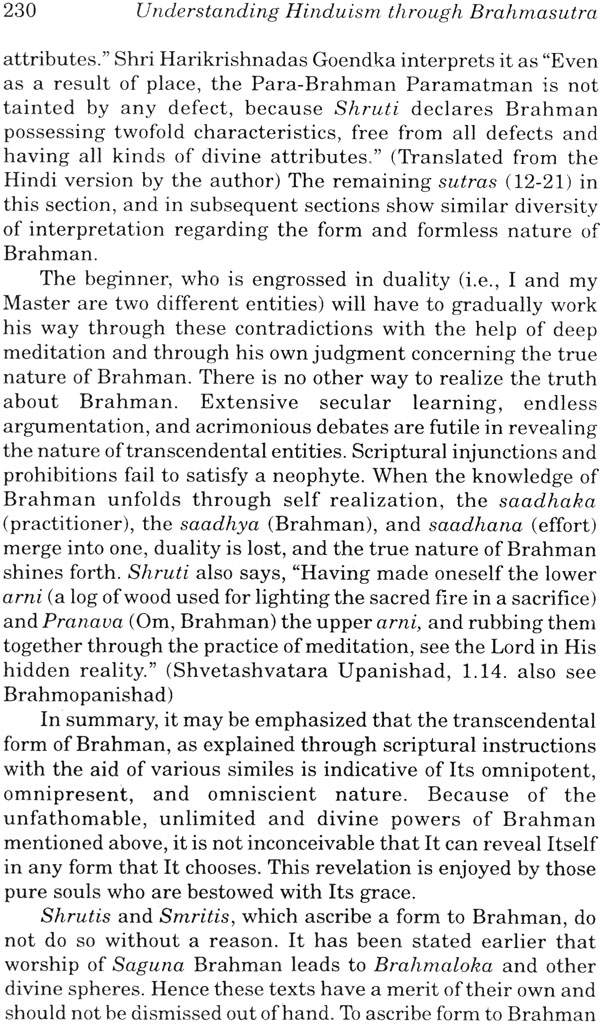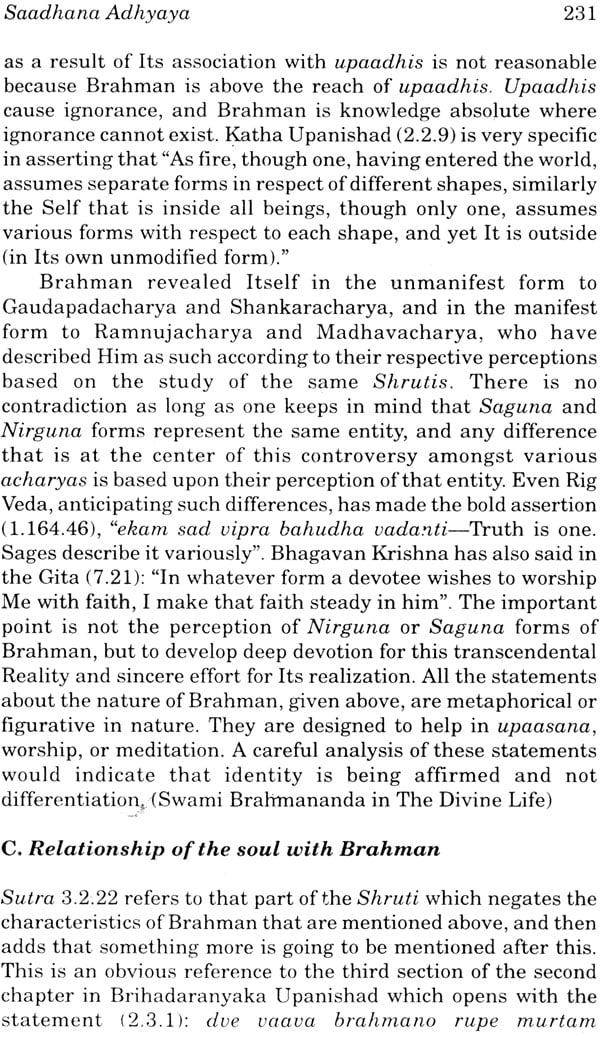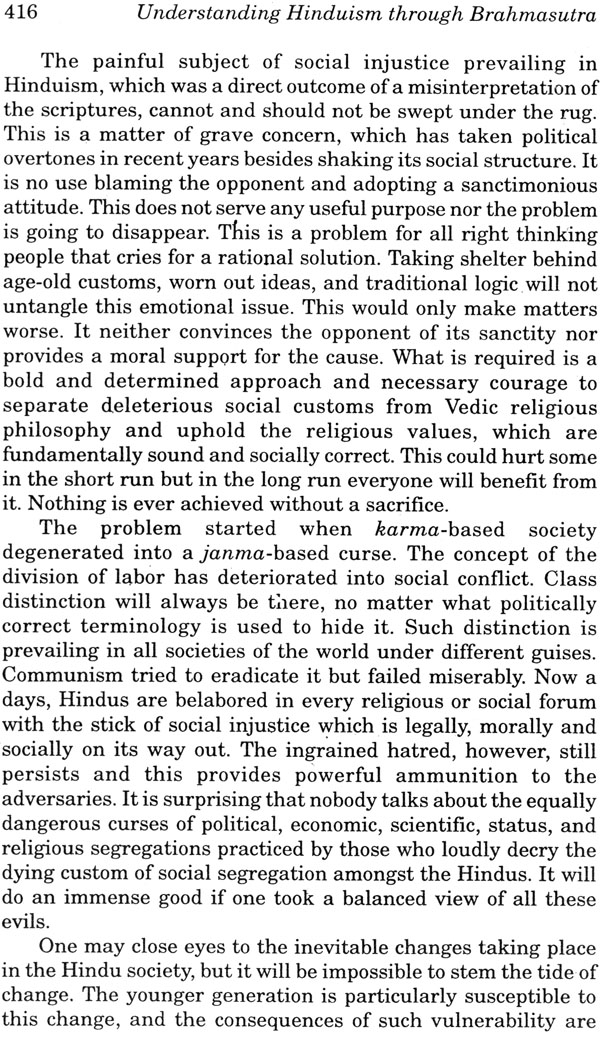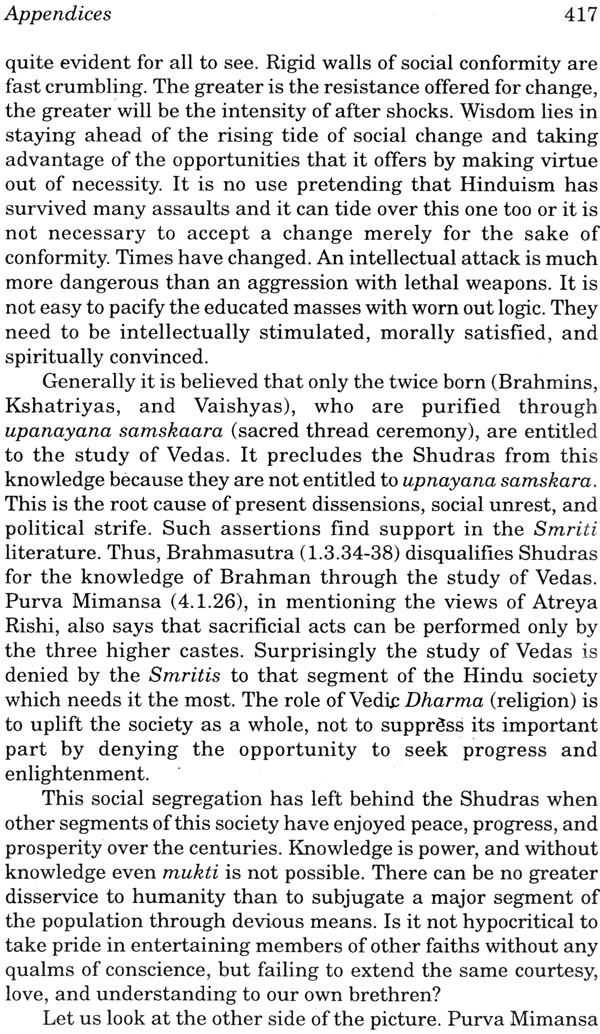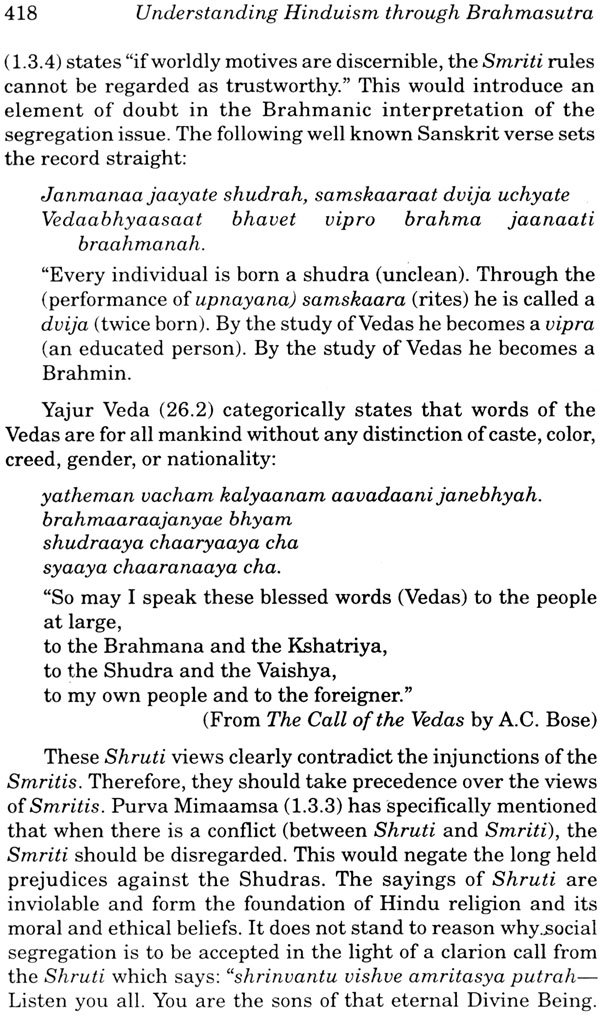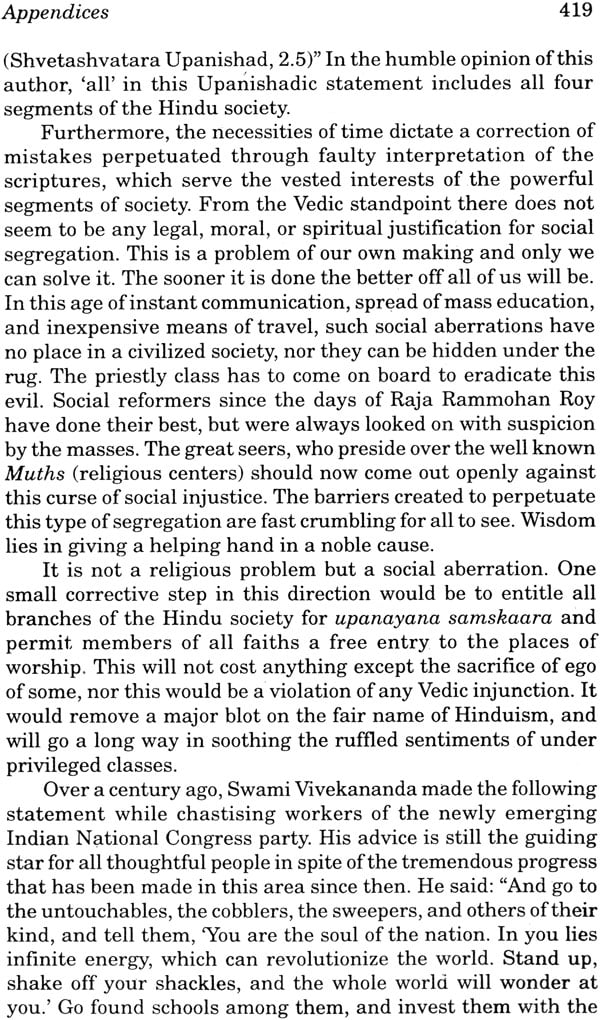
Understanding Hinduism Through Brahmasutra
Book Specification
| Item Code: | NAE775 |
| Author: | M.S Manhas |
| Publisher: | B.R. Publishing Corporation |
| Language: | English |
| Edition: | 2010 |
| ISBN: | 9788176466790 |
| Pages: | 490 |
| Cover: | Hardcover |
| Other Details | 9.0 inch X 6.0 inch |
| Weight | 750 gm |
Book Description
Brahmasutra is an ancient treaties on Hindu religious philosophy. Its 555 aphorisms encapsulate the Knowledge of the supreme which is the theme of 108 Upanishads. An understanding of Vedanta philosophy that is the basis of Hindustan in incomplete without a thorough understandof this valuable scripture.
Brahmasutrawas composed in the sutra(short and statement) ferment by Rishi Veda Vyasa; It is therefore difficult to comprehend its purport without an elaborate commentary.
Many outstanding commentaries on Brahmasutra have been published by learned Swamis and erudite academicians that are beyond the I the level of understanding of the general public. There authors take it for granted that readers are familiar with the terminology and principles of Vedanta :this however, is not the case. These commentators have emphasized their point of view on such abstract topic as the concept of Nirguna and Saguna Brahman existence of one soul that contentious argument and counter arguments confuse the beginners. These are some of the reasons why Brahhmasutra does not enjoy the wide popularity that it deserves. The present volume is planned to ring over this gap in understanding.
Each aphorism has been explained an an easily understandable language Attempts also have been made to focus on the Shruti texts upon which some of them are based .most of the Vidyas (meditations) that are mentioned or implied in the text have been summarized so that neophytes can easily comprehend their significance vis a vis their own quest for enlightenment
Search for the supreme Reality, which is the main purpose of Brahmasutra, is a unique journey that involves no travels. One has only to carefully look inwards, come face to face with this Reality, and enjoy the supreme Bliss that everyone is seeking. The key to the mental, morel and spiritual success is easily accessible through a study of Brahmasutra An Exposition of Hindu Philosophy It is hoped that this text will serve as a useful guide for practitioners and preachers alike.
Dr. Maghar S.Manhas (1922) is an Emeritus Professor of Chemistry at Stevens Institute of Technology, Hoboken, New jersey, U.S.A He has made outstanding contributions to research and received several awards; he has co-authored more then 300 research paper and two books on chemistry related to penicillin antibiotics.
In recant years Dr. Manhas undertaken the study of Hinduism with special interest in Vedanta Philosophy. He has Published three books on this subject titled” Shrimad Bhaagavaad Gita the Eyes of a Scientist(1997),” ‘The Holy Vedantic Life (2003)”, The Hindu Concept of Religion A Scientific View(2005).”
Dr. Manhas has actively promoted Vedantic teaching through his writing and lectures to learned audiences interested in the religious of the East that is non sectarian and beyond the limitations of color, caste creed gender and nationality.
Brahmasutra is an ancient religion philosophical treatise . It encapsulates it within its 555 sutras (aphorisms) the Knowledge given in the Jnanakanda (Knowledge part) of the entire Vedic corpus. because of the breadth and complexity of the information, esoteric nature of the enshrined knowledge, Diversity of the subject exemplified through a lot of imagery , and a cryptic style of the presentation, Brahmaputra’s difficult to comprehend without an elaborate commentary and its sophisticated teaching are still mare demanding to proactive. Although Brahmaputra’s regarded a one the three fundamental text (Prasthana Trayi) of Vedanta, the other two being the Upanishads and the Bhagaved Gita, yet it does not enjoy the same popularity and public acceptance in spite of the fact that it provides an integrated philosophy of lf . this should not be so. An understanding of Vedanta is incomplete without a though of his invaluable text.
Now a day there is (a tendency to explain away the general apathy to word this important treatise by saying that it is a Bhikshu Sutra, which is meant primarily for sannyasis and recluses, who have renounced the world and have enough time at their disposal to study, comprehend, and proactive its teachings. This may be partly true but in reality it is only a convenient excuse to avoid the study of his this difficult text However, this is not a valid reason to deprive the masses from the spiritual benefits that accrue a study of this important treatise. The spiritual leaders also bear the responsibility for not reaching out to devotees and popularizing its teachings. A more difficult subject demands a more erudite experienced to dedicated teacher who can motivate the student to achieve higher goals though personal example. No serious student of Vedanta can afford to neglect this indispensable source of Philosophy which forms the foundation of Santana Dharma Even Bahaman Krishna has taken note of Brahamasutra’s important when .He says in the Gita (13.1):
The sages have sung about this (body and soul) in many different ways and in various sacred chants (Vedic hymns). The aphorisms of Brahmasutra (sentences which are indicative of and lead to Brahman )have also provide a convincing reasoning ,”
Brahmasutra enriches the aspirant with knowledge of the Self him from the darkness of ignorance, and progressively leads him to enlightenment . it is important that this ocean of nectar, in which the key of the spiritual moral and ethical success is hidden , is made accessible through easily comprehensible language to preachers and practitioners alike .
The difficulty in comprehending the complexity of Brahmasutra teachings arises from the fact it covers a broad range of disparate subject on religion, philosophy, transmigration of soul, theory of karma, cosmology, etc. It also teaches a number of Brahmavidyas (meditations on Brahman ) whose practice can lead the practitioner to higher to a higher plain of existence from where there is no return to the life and death cycle.
A number of excellent commentaries and reviews on Brahmasutra are available. They are written by learned Acharyas and couched in sophisticated language. These commentaries are no less difficult to understand by a saadhaka (practitioner). Furthermore, in the absence of a central authority in Hindustan that can present an authentic explanation of the text , and total freedom enjoyed by the commentators even to the extent of c criticizing the very concept of God , the sages over the centuries the have interjected their own perceptions in their commentaries on Brahmasutra. Each commentator claims that his version is the only authentic commenter claims that his version is the only authentic interpretation of Sutrakaare’s ( aphorists) intention. This has compounded the already existing confusion and has generated heated debates and acrimonious conflicts amongst vicarious Sampradayas ( religion sects). Needless to say that these commentators base their opinions on the same source material but interpret differently certain basic principles of Vedanta, such as the nature of Brahman, Jiva and the phenomenal world.
In advancing the concept of the universe and its relationship with the supreme Reality, Baadaraayanahas primarily followed the principle of sound logic backed by the teaching of he Upanishads For him , shrutis (revealed texts) are the only reliable of information for comprehending the transcendental phenomena. Only those amities (remembered texts), such as Gita and Manusmriti, which do not contradict the Vedic concept have been accepted as supporting evidence for his arguments. The Knowledge given in the Shrutis is considered authentic because it was discovered by the ancient sages through deep meditation and directly facing the absolute reality. They have passed on this Knowledge is infallible and without any fault or doubt. Any suspicion regarding its authenticity can be removed by following the same method of investigation which those seers had had used Transcendental Knowledge requires transcendental means to substantiate it , There is no other way to go. Argument to the contrary cannot lead to any reasonable conclusion, because one can Keep moving in circles ad infinitum. Katha Upanishad (1.2.23 says:” The Ataman is not comprehended through much study nor through extensive hearing of spiritual discourses. It can be Know only by him to whom It chooses to reveal Its true nature.” Scriptures suggest four means to comprehend Reality:
Bhagavan Krishana says in the Gita (5.2) that actually there are only two paths to achieve this end, namely, Jnaana maarga and Karma maarga. Dhyaana maarga and Bhakti maarga are subsets of maarga. It is easier for a seeker to proactive Karma marga than Jnaana (5.6) In Dhyaana maarga, the practitioner meditates on the Formless Eeality (Nirguna Brahman)and in Bhakti maarga he worship the anthropomorphic entity (Suguna Brahman Ishtar devotional meditation.
In line withthesearguments, Bhagavata Purana (12.3.53), a comprehensive guide book on Bhakti maarga , has mentioned that bhakti (worship of Ishvara) Provides the same result in Kali Yuga (the present age) as the practice of Dhyaana (meditation on Brahman) did in earlier Yugas (cosmic cycles)
What when achieved by meditating on (Bhagavan) Visnu in Satya yuga , through sacrifices in Treta Yuga and by worship through Dvaapara yuga, is obtained in kali Yuga by (merely) reacting (chanting)the name of the Lord.”
This verse suggests that: (a) Perfection in devotion can be achieved by practicing the well Know acts of devotion,, such as singing and chanting of devotional songs attending place of worship and visiting centers of pilgrimage, prying before the chosen deity, donating liberally in charity, ets and (b). Because of heavy constraints imposed by space, time and social obligations of the present age, devotion to Ishtar is believed to be easier then meditation on the Absolute Brahman. Taking this as a license, the seekers tend to adopt the easier course of devotional practices in preference to the supposedly more ‘difficult’ alternative of meditation . This however, is an oversimplification of the path of devotion and misses its essence by emphasizing from over substance. In fact Bhakti is far more demanding then what its common practice suggests. The lives of Tulsidas, Surdas, Mirabai, Shabri, Narsi Bhakat, and many others very vividly illustrate the trails and tribulations that these devotees had to endure while traveling on the path of devotion.
Brahmasutra of Baadaraayana constitutes the most important, a thorough exposition of Vedanta philosophy in a very cryptic format. Its sutras(aphorism) epitomize the essence of Upanishadic literature which forms the basis of Vedanta the foundation stone of Hindustan. The Upanishadic Knowledge is complex, extensive, scattered, and difficult to assimilate by neophyte. In the present set up, the beginners in this field have neither the time, nor facilities, nor patience to understand the nuances of the diverse, esoteric, and religion Philosophical topics of Vedanta. They went crystallized and simplified version of Vedanta Knowledge which is easy to understand and uncomplicated to practice. Because of the constraint of time. Space, and circumstances imposed by modern civilization a common person usually relies upon annoteated versions of Vedanta which leave out its more important and esoteric principles.
Rishi Baadaraayana, the author of Brahmasutra, has pieced together in this text,, the more significant concepts of Vedanta philosophy found in the Upanishads. According to Brahmasutra Bhashya of Swami Shankaracharya, the system that we have followed, the text is divided into four Adhyayas (Chapter), each Adhyayas is divided into four Padas (Quarters) each pada is further subdivided into a number of adhikaranas (sections, and each adhikarana contains one or more sutras (thread, aphorisms). Brahmastra contains a total of 4 adhyayas, 16 padas, 191 adhikaranas, and 555 sutras.
Brahmastra expounded an orthodox system of Indian Philosophy and derives its authority from the shrutis, especially the principal Upanishads. Shrimad bhagavad Gita commonly called Gita, Mahabharata, and Manusmriti have also. Influenced Baadaraayana’s thinking in composing this treatise.
Although the teachings of Vedanta are dispersed throughout the body of the vadas, as dispersed in sesame seed (Muktikopandishad), yet a concise description of this religion philosophical concept can be easily grasped through a study of Prasthana Trayi ( triple canon of Vedanta).The three standard text are: Upanishad , shrimad Bhagavad Gita. and Brahmasutra. The Upanishad are called Shruti Prasthana as they from the concluding part of the Vedas. Shrimad Bhagavad Gita is designated Smriti Prasthana, because its teaching are based upon the philosophy enshrined in the Upanishads. Brahmasutra as know as Nyaya Prasthana because it explain the Vedanta philosophy in a logical manner using arguments based on the scriptures as well as the experience of the realized sages. Brahmasutra has been designated variously by the scholars. Some of the appellations are Brahmasutra, which signifies that the subject matter of its text is Braman. the supreme reality. Vedanta sutra, because its aphorisms deal with the religio philosophical concepts of Vedanta. Shriraka Sutra, as its text expound the nature of Jiva, the embodied soul. Bhikshu sutra because its teachings are best practiced by Bhikshu and Sannyasis who have renounced the world and devote all their time and energy exclusively in the pursuit of self realization. Uttara, which show that it is an inquiry into the teachings of Upanishads, the concluding g parts of the Vedas.
In spite of the fundamental importance of Brahmasutra in the understanding of Vedanta, it is currently treated as a forgotten scripture. There are several commentaries by ancient sages, but are too difficult to understand by a common person, Even the Veanta scholars in their recant publication, introduce the subject of Vedanta with a reference to Prasthana Tyayi , but confine their subsequent discussion primarily to Upanishads and Bhagavad Gita. With the result , most of the ‘educated elite’ not to speak of a common person , is not even aware of the existence of this important text and depth of knowledge in it.
| Preface | XV | |
| Introduction | XXIX | |
| 1 | The Teachings of Brahmasutra in a Nutshell | XXX |
| 2 | Saadhana Chatushtaya (Practice of four means | XXXI |
| 3 | Brahman is beyond Time, Space and Cousation | XXXIV |
| 4 | The concept of Advaita, Vishishta Advaita and Dvaita in vedanta | XXXIX |
| 5 | Age and Authorship of Brahmmasutra | XXXVII |
| 6 | The concept of Advaita, Vishishta Advaita and Dvaita in vedanta | XXXXIX |
| (a) | Advaita (Nondualism of Swami Shankaracharya | XI |
| (b) | Vishishta Advaita (Quallified Non dualism)of Swami Ramanujacharya | XlIV |
| (c) | Dvaita (Dualism) of Swami Madhvacharya | XIVI |
| 7 | Some Vedic Principles | XIVII |
| 8 | The Role of Meditation in Understanding Brahmastura | lIX |
| 9 | The Role of a Guru in Understanding | l |
| 10 | Three Enemies of Self Realiztion | lIX |
| 1 | Samanvaya Adhyaya Chapter on Reconciliation | 1 |
| Pada (Part) One | 1 | |
| Pada (Part) Two | 48 | |
| Pada (Part) Three | 73 | |
| Pada (Part) Four | 112 | |
| 2 | Avirodha Adhyaya Chapter on Non contradiction | 145 |
| Pada (Part) One | 145 | |
| Pada (Part )Two | 158 | |
| Pada (Part) Three | 182 | |
| Pada (Part) Four | 198 | |
| 3 | Saadhana Adhyaya Chapter on Spiritual Practices | 207 |
| Pada (Part) One | 207 | |
| Pada (Part) Two | 217 | |
| Pada (Part) Three | 237 | |
| Pada (Part) Four | 292 | |
| 4 | Phala Adhyaya Chapter on results | 315 |
| Pada (Part) One | 315 | |
| Pada (Part) Two | 326 | |
| Pada (Part) Three | 337 | |
| Pada (Part) Four | 344 | |
| Epilogue | 381 | |
| Appendices | ||
| Appendix A | 389 | |
| Appendix B | 413 | |
| Bibliography | 423 |
